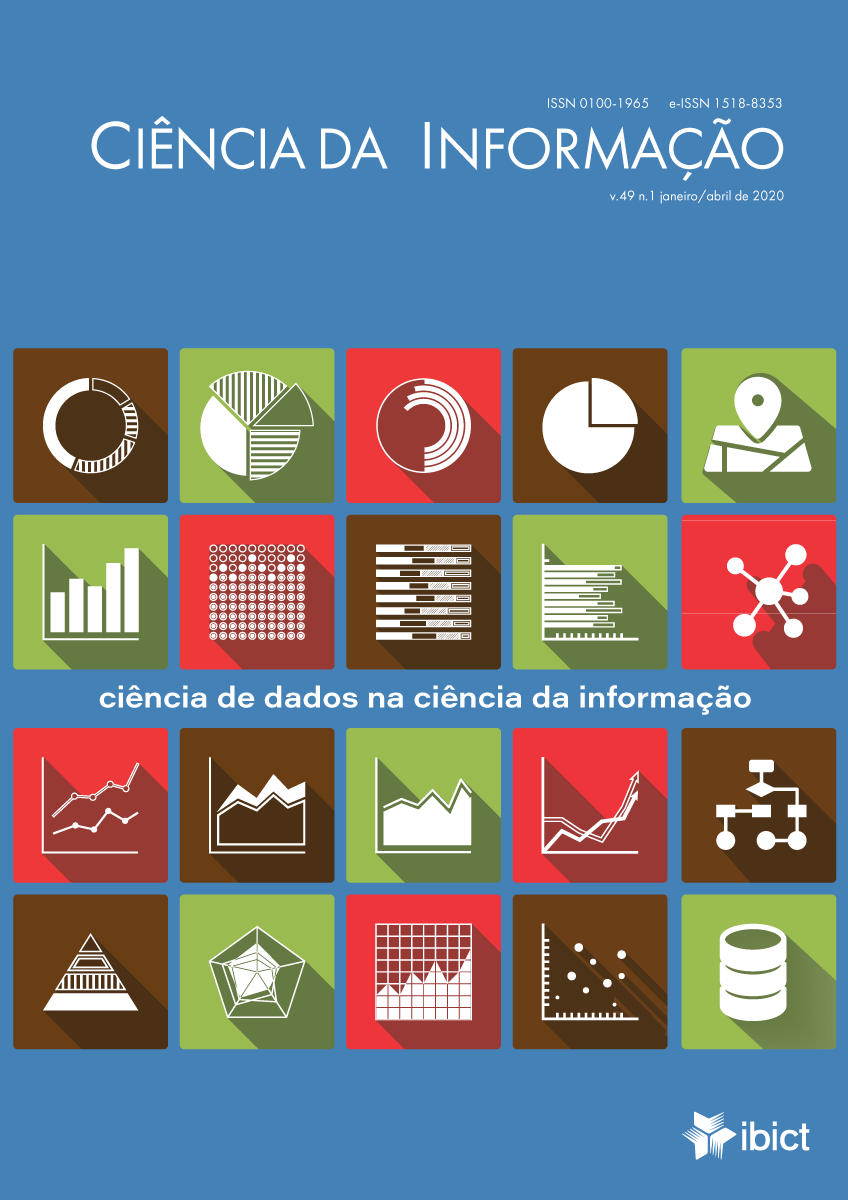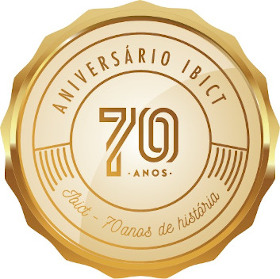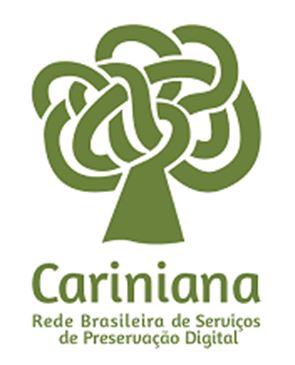Estimación de colaboraciones futuras sobre datos sobre actividades científicas
DOI:
https://doi.org/10.18225/ci.inf.v49i3.5470Palabras clave:
colaboración científica, predicción de enlaces, Plataforma LattesResumen
En una red de colaboración científica, se forma una conexión cuando dos o más científicos publican un trabajo juntos, en cuyo caso, los trabajos representan los bordes y los científicos representan los nodos de la red. Utilizando conceptos del análisis de redes sociales, es posible comprender mejor la relación entre nodos. El trabajo en cuestión tiene como objetivo hacer la predicción de las conexiones en redes de coautoría formadas por médicos con currículos registrados en la Plataforma Lattes, y cuya área de actividad son las Ciencias de la Información. Actualmente, la Plataforma Lattes tiene 6.6 millones de CV de personas y representa uno de los repositorios científicos más relevantes y reconocidos a nivel mundial. Con esto, es posible comprender el comportamiento de la red y monitorear su evolución a lo largo del tiempo. Para eso, algunos pasos son necesarios, son: extracción de datos, creación de redes de coautoría, definición de los atributos que se utilizarán, creación de un conjunto de datos y, finalmente, utilizarlos como entrada en un algoritmo de aprendizaje de máquinas. A través de los resultados es posible establecer, con precisión, la evolución de la red de colaboraciones científicas de los investigadores a nivel nacional, ayudando así a las agencias de financiación en la elección de futuros investigadores destacados.
Descargas
Referencias
ADAMIC, L. A., ADAR, E. Friends And Neighbors On The Web. Social Networks, Elsevier, 2003, v.25, n. 3, p. 211–230.
BARABÁSI, A.-L. E ALBERT, R. Emergence of scaling in random networks. Science, American Association for the Advancement of Science, 1999, v.286, n.5439, p. 509–512.
CAÑIBANO, C.; BOZEMAN, B. Curriculum vitae method in science policy and re-search evaluation: the state-of-the-art. Research Evaluation, v. 18, n. 2, p. 86-94, 2009.
CHEN, H., LI, X., HUANG, Z. Link Prediction Approach to Collaborative Filtering. Ieee. Proceedings Of The 5th Acm/Ieee-Cs Joint Conference On Digital Libraries (Jcdl’05), 2005, p.141–142.
DIAS, T. M. et al. Modelagem E Caracterização De Redes Científicas: Um Estudo Sobre A Plataforma Lattes. Brasnam-Ii Brazilian Workshop On Social Network Analysis And Mining, 2013. p. 10–20.
DIAS, T. M. R. e MOITA, G. F. A Method For The Identification Of Collaboration In Large Scientific Databases. Em Questão, 2015, Vol. 21, N. 2, p. 140–161.
DIAS, T. Um Estudo Da Produção Científica Brasileira a Partir De Dados Da Plataforma Lattes. Programa De Pós-Graduação Em Modelagem Matemática E Computacional, Cen-tro Federal De Educação Tecnológica De Minas Gerais, Belo Horizonte (Doutorado), 2016, 181p.
DIGIAMPIETRI, L. A; SANTIAGO, C. R. N.; ALVES, C. M. Predição de coautorias em redes sociais acadêmicas: um estudo exploratório em Ciência da Computação. In: BRAZILIAN WORKSHOP ON SOCIAL NETWORK ANALYSIS AND MINING, 2, 2013, Anais… Maceió, 2013.
DIGIAMPIETRI, L. et al. Um Sistema De Predição De Relacionamentos Em Redes So-ciais. Brazilian Symposium on Information Systems, 2015, V. 11.
HASAN, M. A. e ZAKI, M. J. A Survey of Link Prediction In Social Networks. Social Network Data Analytics. Springer, 2011, p. 243–275.
LANE, J. Let’s Make Science Metrics More Scientific. Nature, Nature Publishing Group, 2010, v. 464, n. 7288, p. 488.
LIBEN-NOWELL, D. e KLEINBERG, J. The Link-Prediction Problem for Social Net-works. Journal of The American Society For Information Science And Technology, Wiley Online Library, 2007, v.58, n.7, p.1019–1031.
LIMA, H. et al. Aggregating productivity indices for ranking researchers across multiple areas. In: PROCEEDINGS OF THE 13TH ACM/IEEE-CS JOINT CONFERENCE ON DIGITAL LIBRARIES, ACM, p. 97-106, 2013.
LIU, Z. et al. Link Prediction in Complex Networks: A Local Naïve Bayes Model. Epl (Europhysics Letters), Iop Publishing, 2011, v.96, n.4, p.48007.
LÜ, L. e ZHOU, T. Link Prediction in Complex Networks: A Survey. Physica A: Statis-tical Mechanics And Its Applications, Elsevier, 2011, v.390, n.6, p.1150–1170.
MARUYAMA, W. T. e DIGIAMPIETRI, L. A. Co-Authorship Prediction In Academic Social Network. Sbc. Anais Do V Workshop Brasileiro De Análise De Redes Sociais E Mineração, 2019. p.79–90.
MENA-CHALCO, J. P.; CESAR-JUNIOR, R. M. Prospecção de dados acadêmicos de currículos Lattes através de scriptLattes. In: HAYASHI, M. C. P. I.; LETA, H. E. J. (Orgs.). Bibliometria e Cientometria: reflexões teóricas e interfaces. São Carlos: Pedro & João, p. 109-128, 2013.
MENA-CHALCO, J. P.; et al. Brazilian bibliometric coauthorship networks. Journal of the Association for Information Science and Technology, v. 65, n. 7, p. 1424-1445, 2014.
NEWMAN, M. E. The structure of scientific collaboration networks. Proceedings of the national academy of sciences, National Acad Sciences, 2001, v.98, n.2, p. 404–409.
NEWMAN, M. E.; PARK, J. Why social networks are different from other types of net-works. Physical Review E, APS, 2003, v. 68, n. 3, p. 036122.
PEREZ-CERVANTES, E. et al. Using link prediction to estimate the collaborative influ-ence of researchers. In: IEEE 9TH INTERNATIONAL CONFERENCE ON ESCI-ENCE (ESCIENCE), 9. Anais… China, Beijin, p. 293-300, 2013.
POTGIETER, A. et al. Temporality in Link Prediction: Understanding Social Complexi-ty. Emergence. Complexity & Organization (E: Co), Citeseer, 2009, v.11, n.1, p.69–83.
SIDONE, O. J. G.; HADDAD, E. A.; MENA-CHALCO, J. P. A Ciência nas Regiões Brasileiras: Evolução da Produção e das Redes de Colaboração Científica. Transin-formação. v. 28, n. 1, p. 15-31, 2016.
ZHOU, T., LÜ, L., ZHANG, Y.-C. Predicting Missing Links Via Local Information. The European Physical Journal B, Springer, 2009, v.71, n.4, p.623–630.
Descargas
Publicado
Número
Sección
Licencia
Derechos de autor 2020 Thiago Magela Rodrigues Dias

Esta obra está bajo una licencia internacional Creative Commons Atribución-CompartirIgual 4.0.
- La publicación se reserva el direcho de realizar, en los originales, cambios de orden normativa, ortográfica y gramatical, para mantener la norma culta del idioma, respetando el estilo de los autores;
- Las pruebas finales no seran enviadas a los autores;
- Los trabajos publicados pasan a ser propriedad de la revista Ciência da Informação, siendo su reimpresión total o parcial, sujeta a autorización expresa de la dirección del IBICT;
- Debe ser consignada la fuente de publicação original;
- Són de exclusiva responsabilidad de los autores las opiniones emitidas en sus artículos;
- Cada autor recibirá dos ejemplares de la revista, caso esté disponible en el formato impreso.




























